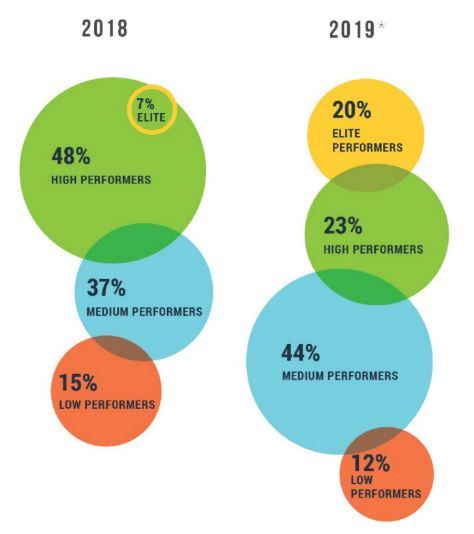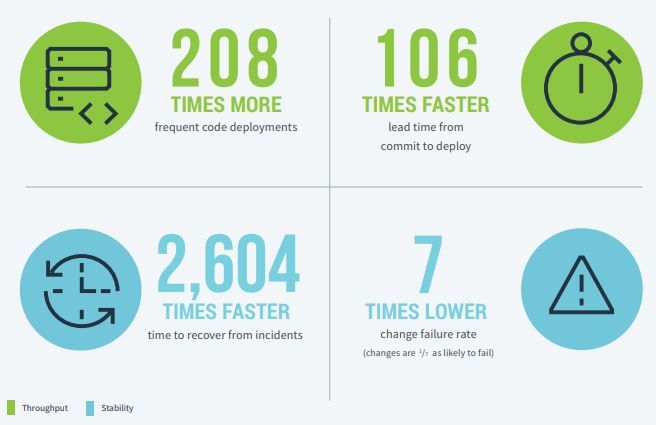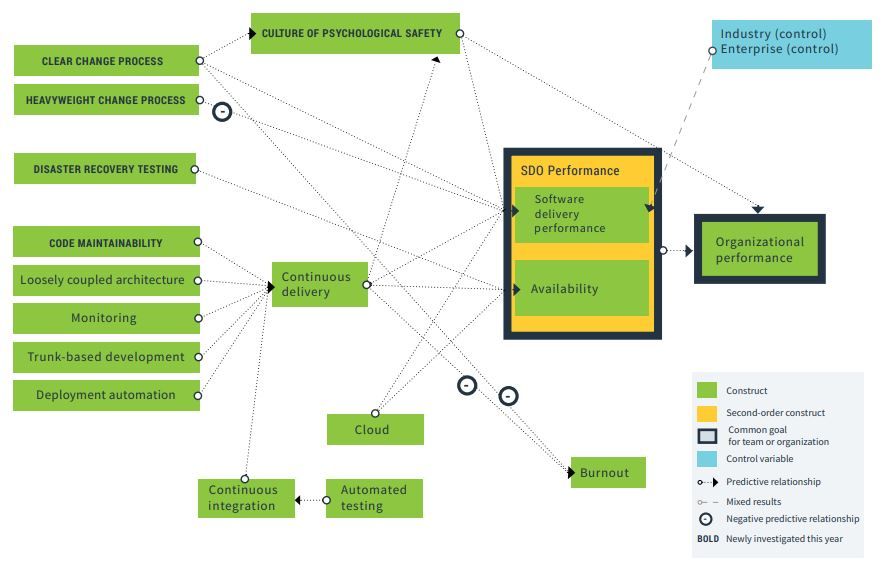DORA (DevOps Research and Assessment), a known name focused on helping organizations with increased DevOps performance trough data-driven insights, and Google Cloud, launched the 2019 Accelerate State of DevOps Report!
Why are we excited about this? The IT industry runs on information and reports are a great source of data, especially when they provide a detailed history of DevOps, shining a light on the improvements needed by companies in order to achieve a top DevOps performance. The insights of 2019 show a report with six years of research, with a majority of respondents working as engineers or managers within the tech industry, targeting more than 31,000 professionals worldwide. What is there to know you ask? Plenty! DevOps has become much more than a movement. Nearly every IT organization wants or is making plans to be part of the DevOps family, a logical and natural choice for plenty of businesses due to the many benefits. DevOps has given companies the chance of increased software development, a combination of speed, agility, and scalability, ensuring operational wonders. Who wouldn’t want to board this train right?
Let’s jump right into it!
Participants who work in DevOps teams have increased since the study started, reporting 16% in 2014, 19% in 2015, 22% in 2016, and holding steady around 27% for the past three years. Similar to last year, most respondents work within the technology industry, followed by financial services, retail, and others.
The DevOps presence and knowledge across industries is the new norm, resulting in high performers. Amongst these talented professionals, there are elite teams of performers that continue to grow, and the numbers from 2019, when compared to 2018, backs-it up.

The contrast from both years highlights the following:
- The number of elite performers has almost tripled;
- The amount of low performers is down;
- The number of medium performers is up.
When it comes to comparing elite performers with low performers, the elite group delivers higher accomplishments in the following subjects:

The 2019 report established that:
• Cloud usage is more likely with elite performers: The top-performing DevOps teams are 24 times more likely to execute all five cloud computing capabilities than low performers, specifically, on-demand self-service, broad network access, resource pooling, rapid elasticity, and measured service. These are the capabilities of cloud computing as defined by the National Institute of Standards and Technology (NIST).
• The majority of cloud users aren’t taking advantage of its extensive advantages: Although the cloud is all about providing fast scalability and reliability, among several other advantages, only 29% of the enquired professionals met all the five capabilities established by NIST. This tells us that many organizations that claim to use cloud computing are still to adopt the needed steps that will develop elite performance.
• Industry matters: The retails industry has shown increase performance in speed and stability. In addition, this year’s report shows that no other industry sees better or worse performance. This indicates that regardless of type and size, including controlled and supervised industries such as government, financial services, and retail are able to achieve high levels of performance by employing DevOps practices.
• DevOps in the enterprise: Unprecedented in previous reports, evidence was found where organizations with more than 5,000 employees are lower performers compared to those with less than 5,000 employees. In addition, the report shows that high and elite DevOps performers focus on structural solutions that build community, specifically in four patterns: community builders, university, emergent, and experimenters.
• No “one size fits all” approach: When it comes to investing in DevOps capabilities in large organizations, the focus needs to be on the team-level and on organization-level efforts. Continuous integration, automated testing, and monitoring are some of the efforts that work well at the team level. Organization-level capabilities include the ability to set architectural or change approval policies that span across departments and teams.
The 2019 report highlights these capabilities while outlining the strategies to adopt so others can execute them on a DevOps strategy for utmost effectiveness.
• Proprietary software usage: Low performers use more proprietary software than high and elite performers, showing similar results with the 2018 report. The same report from the previous year found that elite performers were 1.75 times more likely to use open source components, libraries, and platforms.
Improving DevOps
The 2019 report provides two research models, focused on helping improve DevOps in two areas: performance and productivity. The performance research model looks at what can be done to drive organizational performance, providing insights into how cloud, continuous delivery, disaster recovery testing, clear change management, and culture of psychological safety can positively impact software delivery performance. The research also finds that heavyweight change processes don’t work.

The productivity research model shows that organizations can improve engineer productivity by investing in easy-to-use tools and information search, a culture of psychological safety, and by reducing technical debt. Improved productivity also helps drive better employee work/life balance and reduces burnout.

The 2019 report unveils important findings that paint a clear image of the state of DevOps, how it can be optimized, and its impact. Many thanks to DORA, Google Cloud, and to everyone who contributed to this report.





